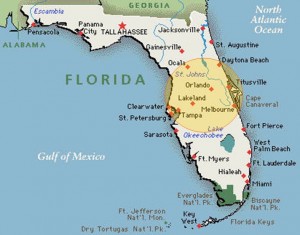© Paul Lachelier 2010. All rights reserved.
The following op-ed was published in the Orlando Sentinel on Tuesday, September 14, 2010, and was picked up two days later by the Chicago Tribune. In December 2010, the U.S. Census Bureau announced how U.S. House seats would be redistributed in accord with state population changes from the 2000 to the 2010 Census. In the 2012 election, Florida will elect two new U.S. House Representatives, bringing its total Electoral College (EC) vote to 29, while the next largest battleground state, Ohio, will elect two fewer Representatives, bringing its total EC vote to 18. This news further increases central Florida’s political significance.
Central Florida is the political epicenter of the world. Sound like the gross exaggeration of an overzealous resident? Everyone knows that Washington D.C. is the nation’s (and maybe the world’s) political epicenter, right? Well, not exactly.
A nation’s capital is typically its political center, that is, the place where national political leaders meet to make decisions, where advocacy groups and lobbyists converge to influence government decisions, where the news media routinely point their cameras and questions when they cover national politics, and where people who consume political news naturally look when they think of politics. For these reasons, Washington D.C. is indeed the political center of the United States.
 But the political center is not always the political epicenter. In earthquakes, the epicenter is the earthquake’s origin, the point from which the shocks reverberate outward and are felt miles and miles away. In politics, as in other domains, there are earthquake epicenters, places where things happen that ripple outward, affecting life far beyond. A nation’s capital is often, but not always, its epicenter because political earthquakes can happen in many places. This is perhaps truest in democracies, where political power is more diffused. And in democracies, it is probably truest during elections, when the eyes of political leaders, activists, and attentive citizens are turned at least for a moment away from the political center, and on the evolving series of earthquakes happening wherever highly consequential elections are occurring.
But the political center is not always the political epicenter. In earthquakes, the epicenter is the earthquake’s origin, the point from which the shocks reverberate outward and are felt miles and miles away. In politics, as in other domains, there are earthquake epicenters, places where things happen that ripple outward, affecting life far beyond. A nation’s capital is often, but not always, its epicenter because political earthquakes can happen in many places. This is perhaps truest in democracies, where political power is more diffused. And in democracies, it is probably truest during elections, when the eyes of political leaders, activists, and attentive citizens are turned at least for a moment away from the political center, and on the evolving series of earthquakes happening wherever highly consequential elections are occurring.
Among democratic elections throughout the world, there is no earthquake more powerful than the American presidential election. Ever since the end of World War II, when the United States emerged relatively intact to become arguably the strongest nation in the world, economically, culturally and politically, more eyes turn to American presidential elections than to any other elections in the world. This is all the more so after 9/11, when the U.S. government became all the more involved globally in order to fight terrorism and secure its interests.
As the scholars Peter Schuck and James Q. Wilson put it colorfully in their recent book, Understanding America, “for better or worse, America is the 800-pound gorilla in every room in the world. When it has an itch, the world scratches. When it gets a cold, the world sneezes.” Nowhere is this truer than in Central Florida.
Florida may not be the most populous state in the nation, but it is the most populous “battleground state” in presidential elections. California, Texas and New York are all more populous than Florida, but they are also “safe states,” where either the Republican or Democratic candidate usually wins in presidential elections. Battleground states like Ohio, Missouri, and Florida matter most in American presidential elections because they are where the Democratic and Republican candidates both stand a chance of winning, where neither candidate’s success is a foregone conclusion. As Americans learned dramatically in the 2000 Bush-Gore contest, the President is actually elected by the Electoral College, not voters. Each state’s number of electors is equal to its total number of U.S. Senators and Representatives. As the nation’s most populous battleground state, Florida has the most electors (27) of any battleground state in the nation. Moreover, since the early 1950s, when Florida was first considered a battleground state, it has only once voted for the losing presidential candidate.
Central Florida – or more exactly, the “I-4 Corridor” stretching from Tampa through Orlando to Daytona Beach – is the battleground of our battleground state. Whereas northern Florida tends to vote Republican and southern Florida tends to vote Democratic, central Florida is where the fate of presidential candidates is most uncertain.
Thus, if it is reasonable to say that American presidential elections are the most portentous political events in the world – the World Cup of global politics – and that Central Florida is the most important region in the world given its critical role in the biggest battleground state in the nation, then every four years, Central Florida is the political epicenter of the world. Whether or not the world knows Central Florida, the world feels the reverberations of its presidential election decisions.